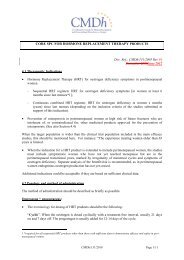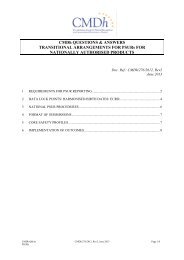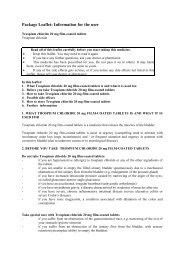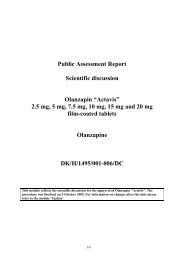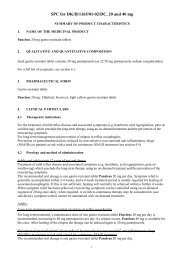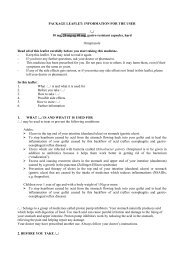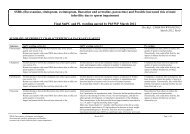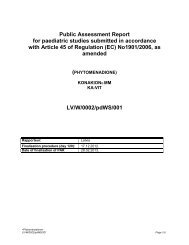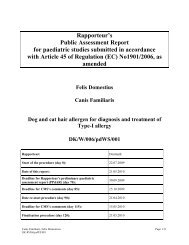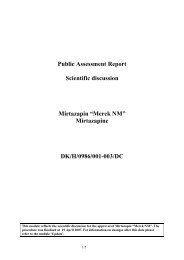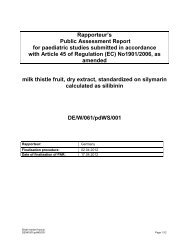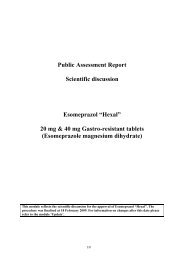Public Assessment Report Scientific discussion Glimepirid “Stada” 6 ...
Public Assessment Report Scientific discussion Glimepirid “Stada” 6 ...
Public Assessment Report Scientific discussion Glimepirid “Stada” 6 ...
You also want an ePaper? Increase the reach of your titles
YUMPU automatically turns print PDFs into web optimized ePapers that Google loves.
<strong>Public</strong> <strong>Assessment</strong> <strong>Report</strong><br />
<strong>Scientific</strong> <strong>discussion</strong><br />
<strong>Glimepirid</strong> <strong>“Stada”</strong><br />
6 mg tablets<br />
<strong>Glimepirid</strong>e<br />
DK/H/0865/005/MR<br />
This module reflects the scientific <strong>discussion</strong> for the approval of <strong>Glimepirid</strong> <strong>“Stada”</strong>. The<br />
procedure was finalised on 4 August 2009. For information on changes after this date please<br />
refer to the module ‘Update’.<br />
1/6
I. INTRODUCTION<br />
Based on the review of the quality, safety and efficacy data, the Member States have granted a<br />
marketing authorisation for <strong>Glimepirid</strong> <strong>“Stada”</strong> 6 mg tablets, from Stada Arzneimittel AG. The<br />
product was authorised in Denmark on 19 April 2007. The product is indicated for the treatment of<br />
type 2 diabetes mellitus, when diet, physical exercise and weight reduction alone are not adequate.<br />
<strong>Glimepirid</strong>e is a long-acting sulfonylurea, the primary mechanism of action of which appears to be<br />
dependent on stimulating the release of insulin from functioning pancreatic cells. This effect is based<br />
on an increase in responsiveness of the pancreatic beta cells to the physiological glucose stimulus.<br />
This mutual recognition procedure concerns a generic application claiming essential similarity with<br />
the reference product Amaryl 6 mg tablets marketed by Sanofi-aventis. Amaryl was approved<br />
nationally in Denmark as 1 mg, 2 mg, 3 mg and 4 mg tablets on 23 October 1995 following the MRP<br />
NL/H/0101/001-004, whereas tablets of 6 mg were approved on 14 April 2003 following the MRP<br />
NL/H/0101/005. In 2007 this strength was withdrawn in Denmark.<br />
The marketing authorisation is granted based on article 10.1 of Directive 2001/83/EC.<br />
Amaryl 2 mg tablets, Aventis Pharma Deutchland GmbH from the German market, has been used as<br />
reference product in the bioequivalence study.<br />
II. QUALITY ASPECTS<br />
II.1 Introduction<br />
Each tablet contains 6 mg glimepiride.<br />
The tablets are orange, flat, oblong tablets (10 x 5 mm) with bevelled edges and a score on one side<br />
and marked with “G” on the other side. The tablet can be divided into equal halves.<br />
The tablets are packed in PVC/Aluminium blisters in pack sizes of 10, 20, 30, 50, 60, 90 and 120<br />
tablets. However, not all pack sizes may be marketed.<br />
The excipients in the tablet are: Lactosemonohydrate; sodium starch glycolate (type A); magnesium<br />
stearate; microcrystalline cellulose; povidone K 29-32 and pigment blend PB-23103 consisiting of<br />
lactose monohydrate and yellow and red iron oxide (E172).<br />
Compliance with Good Manufacturing Practice<br />
The RMS has been assured that acceptable standards of GMP (see Directive 2003/94/EC) are in place<br />
for this product type at all sites responsible for the manufacturing of the active substance as well as for<br />
the manufacturing and assembly of this product prior to granting its national authorisation.<br />
II.2 Drug Substance<br />
The product contains glimepiride as active substance which is monographed in the Ph.Eur.<br />
INN: <strong>Glimepirid</strong>e<br />
Compendial names: <strong>Glimepirid</strong>e (Ph.Eur., BAN & USAN)<br />
Chemical names: a) 1H-Pyrrole-1-carboxamide,3-ethyl-2,5-dihydro-4-methyl-N-[2-[4-[[[[(4methylcyclohexyl)amino]carbonyl]amino]sulfonyl]phenyl]ethyl]-2-oxo-,trans-;<br />
b) 1-[[p-[2-(3-Ethyl-4-methyl-2-oxo-3-pyrroline-1-carboxamido)ethyl]<br />
2/6
phenyl]sulfonyl]-3-(trans-4-methylcyclohexyl)urea<br />
Molecular formula: C24H34N4O5S<br />
Molecular mass: 490.62<br />
Structural formula:<br />
<strong>Glimepirid</strong>e is a white crystalline powder, which is soluble in dimethyl formamide and dimethyl<br />
sulphoxide, slightly soluble in acetone and very slightly soluble in methanol, acetonitrile and ethyl<br />
acetate. It is insoluble in water and dilute NaOH (pH 12.76) and slightly soluble in 0.1N HCl (pH<br />
1.24).<br />
Two diastereoisomer forms exist: cis and trans. The active substance is the trans form.<br />
The applicant sources the substance from two suppliers; one presenting a European Drug Master<br />
File/Active Substance Master File (DMF) and the other holding a Certificate of Suitability from<br />
EDQM, a copy of which has been provided in the file.<br />
The applicant specification for glimepiride is acceptable and complies with general ICH for drug<br />
substance specifications, with the Ph.Eur. monograph and covers additional tests as described in the<br />
EDMF and CEP. All necessary analysis methods and validations are provided.<br />
A retest period of 24 months and 4 years, respectively, has been set for the active substance.<br />
II.3 Medicinal Product<br />
The product composition is adequately described. The development of the product has been<br />
satisfactorily performed and explained.<br />
Excipients are those commonly used in tablet manufacture. The packaging materials are standard and<br />
shown suitable by the presented stability studies.<br />
Product manufacture is standard. Satisfactory validation data are provided for the minimum scale<br />
batches.<br />
The finished product specification is standard for the pharmaceutical form and includes relevant<br />
physicochemical, ID, assay and purity tests. Limits have been appropriately justified. Batch analysis<br />
data on one lab scale and two pilot scale batches are provided showing compliance with the release<br />
requirements and confirming consistency of product manufacture.<br />
Stability data are provided for one lab scale and two pilot scale batches stored in the proposed market<br />
packaging. A shelf-life of 2 years with the storage condition “do not store above 30°C” is approved.<br />
III. NON-CLINICAL ASPECTS<br />
This product is a generic formulation of Amaryl 6 mg tablets, which is available on the European<br />
market. No new preclinical data have been submitted, and therefore the application has not undergone<br />
preclinical assessment. This is acceptable for this type of application<br />
Environmental risk assessment<br />
The product is intended as a substitute for other identical products on the market. The approval of this<br />
product will not result in an increase in the total quantity of glimepiride released into the environment.<br />
3/6
It does not contain any component, which results in an additional hazard to the environment during<br />
storage, distribution, use and disposal.<br />
IV. CLINICAL ASPECTS<br />
IV.1 Introduction<br />
<strong>Glimepirid</strong>e is a well-known active substance with established efficacy and tolerability.<br />
For this generic application, the MAH has submitted one bioequivalence study in which the<br />
pharmacokinetic profile of the test product <strong>Glimepirid</strong> <strong>“Stada”</strong> 2 mg tablets is compared with the<br />
pharmacokinetic profile of the reference product Amaryl 2 mg tablets, Aventis Pharma Deutchland<br />
GmbH from the German market.<br />
From a pharmaceutical viewpoint, the selection of the 2 mg strength for the bioequivalence study is<br />
justified on the basis that:<br />
• All tablet strengths (1 mg, 2 mg, 3 mg, 4 mg and 6 mg) are manufactured by the same<br />
manufacturer at the same site and using the same process,<br />
• The compositions of all strengths are practically identical (apart from colourants) and each<br />
tablet strength contains a low concentration of the active substance (< 5 % of total tablet<br />
weight),<br />
• The dissolution profiles for the 2 mg and 6 mg tablets are similar under identical conditions.<br />
From a clinical aspect, 2 mg is chosen as the pharmacokinetic of glimepiride is linear, and higher<br />
strengths would expose healthy volunteers to an unacceptable degree of hypoglycaemia.<br />
The study was an open label, laboratory blind, randomised, single dose, two-way cross-over study<br />
conducted under fasting conditions with a wash out period of 7 days between the two administrations.<br />
A single dose of 1 x 2 mg was administered in each period with 240 ml water.<br />
Blood sampling was performed predosing and at 0.5, 1.0, 1.5, 2.0, 2.5, 3.0, 3.5, 4.0, 5.0, 6.0, 7.0, 8.0,<br />
10.0, 12.0, 15.0, 18.0, 22.0, 26.0 and 32.0 hours post administration.<br />
32 healthy volunteers were enrolled in the study. All 32 completed the study.<br />
The pharmacokinetic parameters calculated were AUC0-t, AUC0-∞, AUC0-t/AUC0-∞, Cmax, tmax and Kel.<br />
Primary variables were AUC0-t and Cmax.<br />
90% geometric intervals for AUC0-t and Cmax should be within 80-125% in order to conclude<br />
bioequivalence.<br />
Results<br />
Pharmacokinetic parameters (non-transformed values; arithmetic mean ± SD, tmax median, range):<br />
N=30<br />
Treatment AUC0-t AUC0-∞ Cmax<br />
tmax t½<br />
Test<br />
(S.D.)<br />
Reference<br />
(S.D.)<br />
*Ratio (90% CI)<br />
ng.h/ml<br />
729.7<br />
(651.04)<br />
707.0<br />
(612.48)<br />
103.1%<br />
(97.6-109.0%)<br />
ng.h/ml<br />
809.4<br />
(846.15)<br />
757.8<br />
(759.56)<br />
105.5%<br />
(100.8-110.4%)<br />
4/6<br />
ng/ml<br />
105.8<br />
(48.55)<br />
107.2<br />
(41.36)<br />
96.8%<br />
(84.1-111.4%)<br />
h<br />
2.75<br />
(1.00-12.00)<br />
2.00<br />
(1.00-12.00)<br />
0.01 to 1.01 -<br />
CV (%) 12.6 10.1 32.9 - -<br />
h<br />
7.01<br />
(2.61)<br />
6.865<br />
(2.63)
The 90% confidence intervals are within the 80-125% limit as required by current guidelines. Based<br />
on the study <strong>Glimepirid</strong> <strong>“Stada”</strong> 6 mg tablets are considered bioequivalent with Amaryl 6 mg tablets,<br />
Aventis Pharma.<br />
The RMS has been assured that the bioequivalence study has been conducted in accordance with<br />
acceptable standards of Good Clinical Practice (GCP, see Directive 2005/28/EC) and Good<br />
Laboratory Practice (GLP, see Directives 2004/9/EC and 2004/10/EC).<br />
IV.2 Risk management plan & Pharmacovigilance system<br />
<strong>Glimepirid</strong>e was first approved in 1995 and there is now more than 10 years post-authorisation<br />
experience with the active substance. The safety profile of glimepiride can be considered to be well<br />
established and no product specific pharmacovigilance issues were identified pre- or postauthorisation<br />
which are not adequately covered by the current SPC. Additional risk minimisation activities have not<br />
been identified for the reference medicinal product. The MAH has a pharmacovigilance system at their<br />
disposal, which is based on the current European legislation.<br />
The Pharmacovigilance system described fulfils the requirements and provides adequate evidence that<br />
the applicant has the services of a qualified person responsible for pharmacovigilance and has the<br />
necessary means for the identification and notification of any potential risks occurring either in the<br />
Community or in a third country.<br />
V. PRODUCT INFORMATION<br />
SmPC and Package leaflet<br />
The content of the SmPC and package leaflet approved during the mutual recognition procedure is in<br />
accordance with that accepted for the reference product Amaryl tablets marketed by Aventis Pharma.<br />
Readability test<br />
The package leaflet has been evaluated via a user consultation study in accordance with the<br />
requirements of Articles 59(3) and 61(1) of Directive 2001/83/EC. The language used for the purpose<br />
of user testing the package leaflet was English. The test consisted of a pilot test, followed by two<br />
rounds with 10 participants each. The questions covered the following areas sufficiently: traceability,<br />
comprehensibility and applicability.<br />
The results show that the package leaflet meets the criteria for readability as set out in the Guideline<br />
on the readability of the label and package leaflet of medicinal products for human use.<br />
VI. OVERALL CONCLUSION, BENEFIT/RISK ASSESSMENT AND<br />
RECOMMENDATION<br />
<strong>Glimepirid</strong> <strong>“Stada”</strong> 6 mg tablets has a proven chemical-pharmaceutical quality and is a generic form<br />
of Amaryl 6 mg tablets. Amaryl is a well-known medicinal product with an established favourable<br />
efficacy and safety profile.<br />
Bioequivalence has been shown to be in compliance with the requirements of European guidance<br />
documents.<br />
The MAH has provided written confirmation that systems and services are in place to ensure<br />
compliance with their pharmacovigilance obligations.<br />
5/6
The SmPC, package leaflet and labelling are in the agreed templates and are in agreement with other<br />
glimepiride containing products.<br />
Agreement between Member States was reached during a written procedure. There was no <strong>discussion</strong><br />
in the CMD(h). The Concerned Member States, on the basis of the data submitted, considered that<br />
essential similarity has been demonstrated for <strong>Glimepirid</strong> <strong>“Stada”</strong> with the reference product, and have<br />
therefore granted a marketing authorisation. The mutual recognition procedure was finalised on 4<br />
August 2009.<br />
A European harmonised birth date has been allocated (1995-06-20) and subsequently the first data<br />
lock point for glimepiride is 2009-06, after which the PSUR submission cycle is 3 years.<br />
The date for the first renewal will be: 9 May 2010.<br />
The following post-approval commitments have been made during the procedure:<br />
• The Applicant confirms that method transfer and cross-validation will be performed at each site<br />
before any batches are tested and released at the respective site.<br />
• The Applicant confirms that stability studies shall be performed on the first three batches of the<br />
maximum batch size.<br />
6/6



